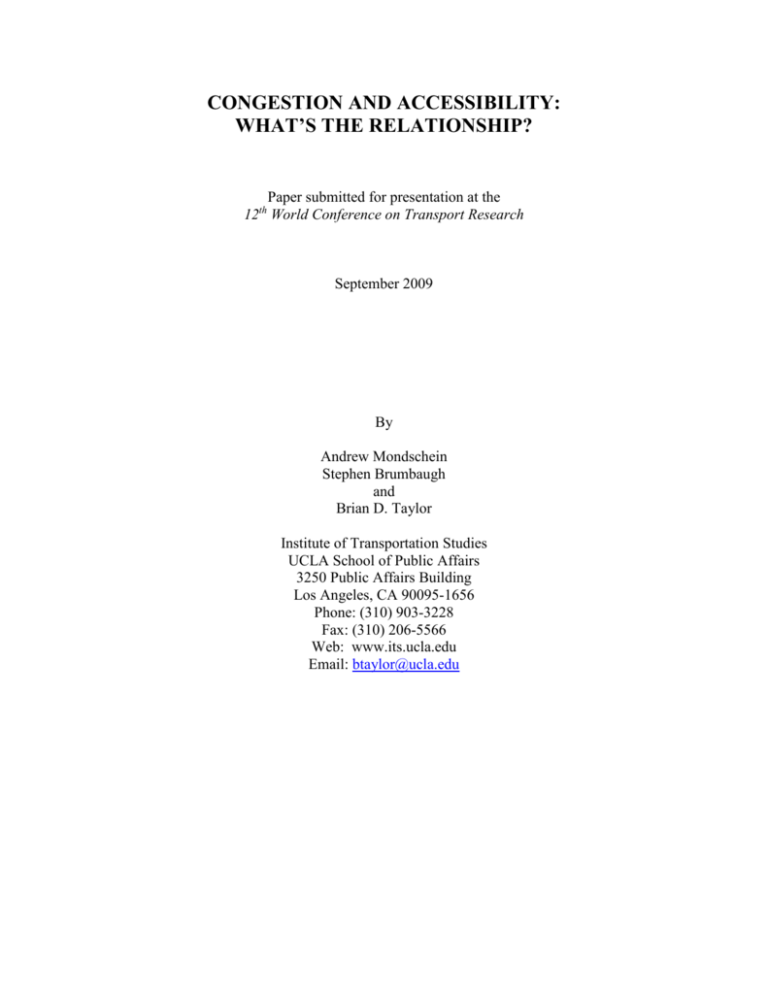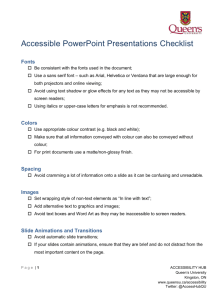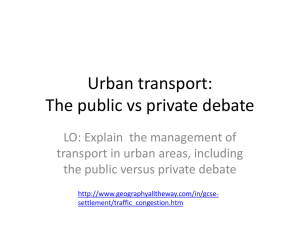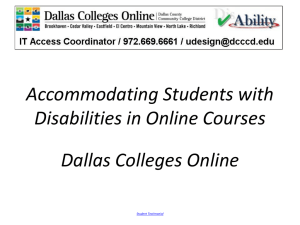congestion and accessibility: what`s the relationship?
advertisement

CONGESTION AND ACCESSIBILITY: WHAT’S THE RELATIONSHIP? Paper submitted for presentation at the 12th World Conference on Transport Research September 2009 By Andrew Mondschein Stephen Brumbaugh and Brian D. Taylor Institute of Transportation Studies UCLA School of Public Affairs 3250 Public Affairs Building Los Angeles, CA 90095-1656 Phone: (310) 903-3228 Fax: (310) 206-5566 Web: www.its.ucla.edu Email: btaylor@ucla.edu ABSTRACT This paper conceptually and empirically explores the complex relationship between congestion and accessibility. While congestion alters individual access to opportunities, its effects vary significantly across people, places, and time, variations that remain relatively understudied. This paper begins by proposing a conceptual framework with three components. First, congestion can constrain mobility and thus indirectly reduce accessibility. Second, congestion is associated with agglomerations of activity and with increased accessibility. Finally, congestion is in part a phenomenon of perception and behavior, cognitively altering an individual’s choice set of destinations and altering actual access to opportunities. To analyze potential connections between congestion and accessibility at subregional scales, we use the 2003 Southern California Association of Governments (SCAG) Travel and Congestion Survey and SCAG estimates of traffic and congestion for freeways and arterial streets. We first explore the overall spatial relationships between congestion and accessibility within a Geographic Information System (GIS). To complement the spatial analysis, we test a basic regression model of individual activity patterns to better understand the relationship between person- and locationbased variation in activity patterns. As our multifaceted framework suggests, we find that congestion does not have a uniform effect on accessibility, but varies substantially by neighborhood. Some neighborhoods appear to be more “congestion adapted” than others by allowing high levels of activity participation despite high levels of congestion. To account for personal characteristics such as income that may influence the spatial analysis, this paper also constructs a model of the number of daily trips as a function of an array of personal and household characteristics. Residuals from the model suggest that place-based neighborhood effects explain the relatively higher levels of travel by residents found in the “congestion adapted” neighborhoods. Sources Casas, I. Evaluating the importance of accessibility to congestion response using a GIS-based travel simulator. Journal of Geographic Systems, Vol. 5, 2003, pp. 109-127. El-Geneidy, A.M. and D.M. Levinson. Access to Destinations: Development of Accessibility Measures. Deparment of Civil Engineering, University of Minnesota, Minneapolis, MN, 2006. Handy, S.L. and D.A. Niemier. Measuring accessibility: an exploration of issues and alternatives. Environment and Planning A, Vol. 29, No. 7, 1997, pp. 1175-1194. Hansen, W.G. How accessibility shapes land use. Journal of the American Planning Institute, Vol. 25, 1959, pp. 73-76. Kwan, M.-P. and J. Weber. Individual Accessibility Revisited: Implications for Geographical Analysis in the Twenty-first Century. Geographical Analysis, Vol. 35, No. 4, 2003, pp. 341-353. Kwan, M.-P., et al. Recent advances in accessibility research: Representation, methodology and applications. Journal of Geographical Systems, Vol. 5, 2003, pp. 129-138. Levine, J. and Y. Garb. Congestion pricing's conditional promise: promotion of accessibility or mobility? Transport Policy, Vol. 9, No. 3, 2002, pp. 179-188. Schoenfelder, S. and K. Axhausen. Activity spaces: Measures of social exclusion? Transport Policy, Vol. 10, 2003, pp. 273-286. Wachs, M. and Kumagai. Physical Accessibility as Social Indicator. Socioeconomic Planning Science, Vol. 7, 1973, pp. 437-456. Weber, J. and M.-P. Kwan. Bringing Time Back In: A Study on the Influence of Travel Time Variations and Facility Opening Hours on Individual Accessibility. The Professional Geographer, Vol. 54, 2002, pp. 226-240.







